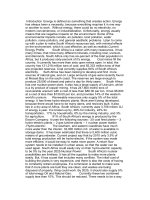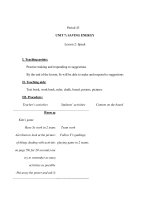Gravitation energy
Bạn đang xem bản rút gọn của tài liệu. Xem và tải ngay bản đầy đủ của tài liệu tại đây (5.75 MB, 118 trang )
THE LAW OF GLOBAL GRAVITY
THE LAW OF GLOBAL GRAVITY
1. Force of gravity, energy and movement
2. Gravitation
Newton's Law of Universal Gravitation
Gravitational Law of Equivalence
Gravitational field
Principle of conservation of matter
Global Gravity Law
3. Energy
Concept and definition of energy
Types of energy
Kinetic energy
Gravitational potential energy
Mechanical energy
4. Energy science experiments
GigaChron experiment
Natural phenomena
Gravitational waves
Gravitational lensing
Mercury's orbit perihelion
Gravitational red shift
PAG.
15
21
21
29
29
37
43
55
55
61
69
75
79
83
85
91
91
99
107
119
Law of Global Gravity
I. FORCE OF GRAVITY, ENERGY AND
MOVEMENT
At present, the Theory of Global Equivalence is the name given to
the selection of seven books on Global Physics which form the
new theory of everything. They cover from the physical
medium of the gravitational and electromagnetic energies,
motion of elementary particles, mass of ordinary matter, black
holes and stars, to several proposals about the origin of the
universe gathered in Cosmology.
The development of the new gravity physics theory has
implied changes in numerous principles and laws of physics,
configuring a theory of unification and what in Physics is
called a theory of everything. We can divide the modified
physics principles of the new paradigm in two large groups:
In the first group, the affected physics principles will
define matter in the general sense (Globus) and its various
states of aggregation such as gravity (globine), mass and
wavine.
In the second one, the physics principles will be related to
Euclidean space and absolute time and all the implications
concerning other magnitudes such as movement, force,
gravity force and energy.
While the Theory of Global Equivalence studies the first group of
physical principles in a book called Global Mechanics and, to
some degree, in Global astrophysics, the second group, in which
gravitational energy and motion are examined, is included in
Global Dynamics, in The Law of Global Gravity and, in some
extent, in the hereinabove mentioned Global Astrophysics.
Distinction between the physical principles affected by the
new theory of everything is made in order to simplify the
explanation of a complex and extensive subject. Besides, it is
15
Law of Global Gravity
connected to the matters laid down in Quantum Mechanics and
in Einstein’s General Relativity, sprang from Newton’s Laws of
Dynamics or causes of motion.
This book about The Law of Global Gravity means a deep and
penetrating analysis on gravitational energy and on the causes
and mechanisms of motion as it includes the reticular structure
of the globine or the physical medium, both of the gravity
field and the electromagnetic energy, as well as the one of
elementary particles and mass.
The new Theory of Global
Moon shadows in Jupiter Equivalence has scientific
NASA (Public domain image) character despite it being
an alternative theory to
Einstein’s
Theory
of
Relativity and, to a large
extent, to the curious
interpretations
of
Quantum Mechanics on
gravity and motion on a
subatomic scale; it then
presents and proposes
possible
physical
experiments to confirm
its assertions.
It is also necessary to point out that the contribution of new
concepts of physical reality with a greater degree of precision
as motion and the properties of reticular structure of matter
supporting the gravitational energy, gravity in a strict sense,
electromagnetic energy and mass, requires the use of
additional names or terms to achieve the essential
terminological clarity and ease of assimilation.
Specifically, chapter II of the book describes the connections
between Newton’s Law of Universal Gravitation, the changes
proposed by Einstein’s Relativity and the view of Quantum
16
Law of Global Gravity
Mechanics about motion and how it is affected by gravitational
energy, both by gravity as a force and by the very existence of
the gravitational field caused by the mass.
Under the new perspective of the Theory of Global Equivalence,
in the above mentioned chapter II, the effects of the
gravitational energy on motion areshown through the
mechanisms of the components of the atractis causa.
Chapter III shows the new approach on gravitational energy
and motion, so a higher precision on the energy concept is
required, especially when talking about mechanical, potential
and kinetic energy. Likewise, the unification of forces and
energies proposed by the previously presented theory of
everything, leads us to make a brief descriptions of the
different types of energy.
The fundamental equation of the new physics theory of unification
and theory of everything relies on the direct relation between
acceleration due to gravitational energy on any point of the
gravitational field and the four most notable physics constants
plus a normalization variable *n*, that curiously equals *1* in
Earth superficies.
Gravitational Law of Equivalence
g = [ c² * h * R / G ] * n
The Global Gravity Law deserves special mention for implying a
different explanation, which is consistent with common sense,
about the decisive predictions of the General Theory of Relativity
of Einstein by means of a small adjustment of Newton’s Law
of Universal Gravitation.
The three great natural phenomena of General Relativity of
Einstein are also discussed and explained with the Merlin
17
Law of Global Gravity
effect and its mathematical integration in the Law of Global
Gravity within the new paradigm or theory of everything and,
of course, within common sense; I am referring to the effect
of the gravitational lens, the gravitational red shift of light and
the precession of the perihelion of Mercury.
Chapter IV includes the
Global Gravity Law
mathematical
calculations
explaining thelight curve, the
perihelion precession of Mercury’s
orbit and the red shift under the
mathematical application of
the Theory of Global Equivalence; being consistent with the new
underlying physical principles about gravitational energy and
motion.
The related links appear in all of the pages where the free online books are included, in which the new theory of unification,
theory of everything or, even better, Global Physics is exposed. This
division is due to numerous reasons such as: metaphysical or
scientific experimental character, mathematical difficulty, the
subject dealt with and presentation on the Internet.
Finally, the Equation of Love online book includes a section with
a complete summary of all the science online books related to
Global Physics (Glóbica or Globics) and its theory of everything or
Theory of Global Equivalence.
***
18
Law of Global Gravity
19
Law of Global Gravity
20
Law of Global Gravity
2. GRAVITATION
2.a) Newton’s law of universal gravitation
Newton integrated the force of gravity on Earth with the
force that governs planetary orbits through his mathematical
Law of Universal Gravitation; but no physical reasoning was
given of the mechanical causes to support it. Newton himself
commented that he did not like forces at a distance.
Subsequently, Einstein’s Theory of Relativity added a slight
distortion of space in order to fit the planetary orbits to
astronomic observations. If Newton’s Law of Universal
gravitation was a purely mathematic law, the Theory of Relativity
uses mathematical equations so complex that not only the
physical interpretation is elusive but that the mathematical
interpretation is itself, in the majority of cases, imaginary. A
friend from Mensa, the herbivore, upholds Einstein’s theories
and has also always had a vivid imagination.
In principle, it seems that two different causes would have to
exist in the theory of gravitation. One that would justify the
classic gravitational force or Newton’s Law of Universal
Gravitation and, the other, the distortion of the anomalous
precession of Mercury’s orbit explained by Einstein’s Theory of
Relativity.
Mathematically, the problem is more or less resolved by the
combination of Newton’s Law of Universal Gravitation and
Einstein’s Theory of Relativity, given that is known the
quantification of energy exchanges, due to the gravitational
forces, between kinetic and potential gravitational energy and
the maintenance of mechanical energy.
Gravitational interaction is responsible for the variations between
kinetic and potential elastic energy associated with mass in the
reticular structure of the matter or globine with radial
21
Law of Global Gravity
symmetry. On the following page of this online book
mechanical energy and the principle of equality between
inertial and gravitational mass will be discussed.
An approximation to the form of interaction of globine with
electromagnetic energy and bodies with mass due to the
gravitational attraction is shown in the online book Global
Dynamics, in the section on Physics of motion with analysis on the
dynamics of light movement and of the bodies with mass in
free fall.
On the other hand, in this book’s section on Energy experiments
the calculation of light curvature in gravitational lens and the
perihelion precession of Mercury’s orbit are studied.
So, the mathematical formula is one thing and the underlying
physical explanation another; the atractis causa topic is
complicated by the existence of two causes or components of
the forces of gravitational attraction; that explain the
acceleration of mass associated with Newton’s classic Law of
Universal Gravitation and with Einstein’s imaginary space-time
distortion relative to the anomalous precession of the
planetary orbits with respect to Celestial Mechanics.
However, the fact that light deflects in a gravitational field
exactly double than mass according to Newton’s Law of
Universal Gravitation makes me suspect that there must exist
some special relationship between the causes of both
deviations.
The theory of everything from the Theory of Global Equivalence
also resolves the problem of calculating the gravitational force
with the Law of Global Gravity equation, whose formula is as
follows:
In this formula from the Law of Global Gravity total mass does
not appear because, doing this would place it on both sides of
the mathematical equation.
22
Law of Global Gravity
It is known that, according to Newton’s law of gravity, the
force of attraction between two bodies is also inversely
proportional to its distance squared. This formula of
gravitational acceleration is equal to Newton’s Law of Universal
Gravitation if we take into account the direct effect of velocity
on gravitational interaction. Understanding always by velocity,
the average velocity with respect to the natural reference
system provided by globine.
According
to
the
mathematical laws proposed
by Global Dynamics, the force
of gravitational attraction is
due to two attractis causa
components.
Global Gravity Law
The first, where the gravitational force is proportional to
total mass, that is, mass at rest plus the mass equivalent to
kinetic energy.
The increase in the force of gravity by the increase in total
mass does not affect Mercury’s orbit, given that the greater
force of gravity must accelerate the greater total mass.
Consequently, in both the formula with only this
component of atractis causa and Newton’s Law of Universal
Gravitation, the mass of the body affected by the force of
gravity does not appear and both results would be identical
with respect to motion.
Therefore, this component is represented by *1* in the
Law of Global Gravity formula.
The second, which implies an additional force from body
velocity.
This second component is half the force of gravity that
electromagnetic energy would suffer due to its speed,
which is equivalent to the kinetic energy of the total mass.
Remember that the curvature of light, because of the
23
Law of Global Gravity
gravitational lens effect, is double the deviation the mass.
One part compensates the increase in total mass and the
other makes up this second component of atractis causa.
In order to add the equivalent mass of kinetic energy to
Newton’s Law of Universal Gravitation formula it is
necessary to correct its value by 2 ; 2 given the double
effect of the gravitational interaction of the kinetic energy,
and due to the character of lineal acceleration in the
aforementioned equation. It is an issue similar to the
difference between Planck’s constant and the reduced
Planck constant.
The Law of Global Gravity represents energy transfers
between the globine and the mass or electromagnetic
energy; therefore, the relevant magnitudes are always
different types of energy; what is more, the mass is a
manifestation of accumulated elastic energy.
The second component of atractis causa from the new theory
of gravitation is named Merlin effect due to its implications
on the movement of bodies with mass (Mercury) and the
propagation of light (Lighting)
The difference of Global Dynamics to the Theory of Relativity is
that while Einstein uses kinetic energy to alter space-time and
balance the planetary orbits; Global Dynamics defines an
additional force or second component of atractis causa, adjusted
also by kinetic energy, to explain the physical reality without
altering it.
As has been mentioned, Newton was aware that his
gravitation theory did not explain the mechanical mechanisms
of the force of gravity, what he called forces at a distance.
Modern Physics not only does not explain the mechanisms of
material reality providing energy for the accelerations already
mentioned or changes in the continuum or, at least, where and
when these mechanisms act, but it also casts doubts on the
24
Law of Global Gravity
most basic concepts of its raison d’être, such as physical
reality, space, time, etc.
Global Mechanics attempts an approximation of said
mechanisms through the interrelation between globine and
mass or, put another way, between longitudinal curvature
tension in the gravitational field or potential energy on the one
hand and both elastic and kinetic energy shown in the form of
mass or electromagnetic energy on the other.
Force of gravitation
Bewitched heart
The figure of the bewitched heart allows for an intuitive
understanding of the force of attraction as a result of the
globine’s vibrations. If we make the strings in the figure
vibrate, any body or energetic property on them will tend to
move upwards or to where the strings are most separate, on
condition that the said body has a neutral spatial orientation.
If the object were to be shaped like a black triangle it could
well move to the contrary; then its spatial configuration would
25
Law of Global Gravity
mean a greater effect on the exchange of energy than that of
the spatial configuration of the strings. A more in depth
analysis of motion can be found in the section on Physics of
movement with gravity from the online book of Global Dynamics.
Homemade physics experiment
As a straightforward, but not exact, example, it can show
that the Merlin effect or second component of the atractis
causa is defined by the additional force of gravitation in the
case that the object were moving on the strings, then it
would produce greater points of contact with the same.
Simple example of the pigeon
With identical imperfect example limitations, it is also
worth considering the idea of a pigeon flying with or
without wind.
In particular and remembering the characteristics of the Global
Mechanics model of Euclidean space, absolute time and of
being renormalizable, I would say that the mechanism of
gravitational interaction is the same one for the deviation of
mass and light curvature; or for the effects of Newton’s Law
of Universal Gravitation and those of Einstein’s Theory of
Relativity in relation to the planet’s orbits.
In other words, I am describing the unification of both atractis
causa components. In this sense what changes from one case
to another is the perspective and quantitative effect of the only
existing mechanism.
The question of spatial configuration in gravitational
interaction is very important since, it allows a more precise
explanation of other concepts that are now, due to so much
relativity and uncertainty, rather confused, such as those of
motion, force, time, space and velocity.
In fact, as much the Law of Global Gravity as Newton’s Law of
Universal Gravitation can not only be rewritten in terms of
26
Law of Global Gravity
energy instead of mass but it would be more suitable. After all,
the chosen units do not alter the outcome; as an example one
can refer to the field equations of Einstein’s General Relativity,
with its conversion to geometric units.
The atractis causa components will be examined in more depth
when discussing motion, kinetic energy and the Laws of Global
Gravity themselves; taking into account the nature of light and
mass according to Global Mechanics.
27
Law of Global Gravity
28
Law of Global Gravity
2.b) Gravitational Law of Equivalence
2.b.1 Force and gravitational field
The concept of gravitation in Classical Physics is an unusual
notion. As it is not known what gravity is, one resorts to the
trick of the definition of a gravitational field with particular
properties that are not anything other than the visible effects
of gravitational force or other gravitational processes.
This gravitational model is useful but we must not forget that
it is a temporary technique to be used until the true nature of
gravity and the origin of the gravitational processes are known.
On the other hand, science is reaching a point of development
that it is getting closer to discover the nature of the gravitational
field and to be able to create a sound model of force and
gravitational field as an alternative to Einstein’s Theory of
Relativity.
A more complete gravitational field concept must take into
account gravity-energy-mass equivalence, a very descriptive
but rather imprecise term.
In any case, the gravitational field cannot be a set of points in
space with properties assigned by a Divine Being or particles
that emerge from the Divine Nothing by Heisenberg’s
Uncertainty Principle or Indetermination Principle; at least, not from
a scientific point of view. Newton said so when stating that he
did not like forces at a distance whilst formulating the Law of
Universal Gravitation.
From a philosophical perspective, as much the Conservation of
Energy Principle as the Global Conservation Principle come to the
same conclusion; that is to say, that things neither appear nor
disappear into the nothingness. It does not matter if we are
talking about processes regarding matter, mass,
29
Law of Global Gravity
electromagnetic energy or energy from a gravitational field.
To that common element of matter as a physical reality that
remains in all its states of aggregation, mass, wavine and globine or
that is the underlying element of the properties of the same,
like electromagnetic energy or strong and weak nuclear energy,
and which cannot be abstract, is that which has been named
Globus.
Force and gravitational field
Something similar exists with String Theory regarding minute
particles which form part of the remaining current
fundamental particles; but, and sorry to put it so bluntly, the
existence of more than three physical spatial dimensions
sounds to me like a fairy tale. Maybe it is language’s
shortcoming or the desire to confuse. Another difference is
that the Theory of Global Equivalence is an alternative to Einstein’s
Theory of General Relativity, so far from integrating it, what it
does is highlight its almost complete incorrection.
The new gravitation theory tries to change or help to change the
current paradigm of physical reality in the main aspects of
relationships between energy and mass with the gravitational
30
Law of Global Gravity
field and its forces; in particular proposing a new Gravitational
Law of Equivalence from an alternative theory to that of
Einstein’s Relativity (explaining the exact scope and
significance of energy-mass equivalence) and eliminating
certain philosophical-quantum relaxation which has taken over
scientific method during the last century (not only in Modern
Physics).
Gravitational Law of Equivalence
The Theory of Global Equivalence is upheld in the Global
Conservation Principle, in its fundamental equation or
Gravitational Law of Equivalence and in some philosophical
hypotheses such as the following:
Physical reality does not depend on the observer, only its
perception and description.
Time is relative from life’s subjective point of view, but this aspect
is irrelevant in the field of objective or conventional physics.
A scientific theory is good if it is useful, but it is much better if,
once understood, it also has common sense.
So serious was the problem that arose from Einstein’s
Theory of Relativity in its day that the philosophy of
scientific method itself had to change. From the
considerations of the famous Vienna Circle everything
goes in science, it does not matter if it is reasonable or
not, it is enough that it is useful and proven with
experiments. For example, an object can be various
things at a time depending on who is looking at it or it
can be in two different places at a time…
Although they do belong to the philosophy of science,
these hypotheses are significant because it is necessary
to give new direction to some aspects of current
philosophy. To make it less utilitarian, appropriate to
technology, and more logical, suitable for science.
31
Law of Global Gravity
In the online book on Global Mechanics a chapter on
physical principles and its scientific and innovative nature
is included.
In the online book on Global Scientific Method a section has
been dedicated to the Method of scientific research in Modern
Physics.
The Theory of Global Equivalence (TGE) is, at its root, a
scientific theory; but it does not try to go into excessive
mathematical technical detail, especially those derived from
the latest technological advances and the more than risky
explanations that are sometimes offered.
Suffice to say that this online book on the new gravitational
field concept and Global Dynamics book belonged to the last
section of the book onthe Equation of Love and that the
same section, in the first edition of November 2003, was
called Towards a new theory, because the TGE had neither
name nor defined content and the Gravitational Law of
Equivalence was found in the shape of the Gravity Riddle.
The Theory of Global Equivalence’s fundamental equation is
the Gravitational Law of Equivalence. It is a formula or
equation that relates physic’s basic constants to
gravitational attraction on the Earth’s surface or, more
commonly, variable physics, that is to say:
Gravitational Law of Equivalence
g = [ c² * h * R / G ] * n
32
Law of Global Gravity
Where all the constants are known apart from nd which is
a variable of dimensional normalization with a value one.
In reality, the dimensions of nd indicate that other variables
are not given the correct dimensions; given that they do
not pick up on the true physical effects of dependency,
while not explicitly considering the effects of some
gravitational processes and of speed, mass and energy.
Additional comment son the TGE’ fundamental equation or
the Gravitational Law of Equivalence can be found in the
chapter on Energy Experiments in this same online book in
the section that discusses the Gigha-Chron Experiment.
G * g = c² * h * RH * nd
This gravitational equation should help the physical
magnitude’s correct configuration and their true
relationship. In particular, the relationship that exists
between the intensity of the gravitational force or
gravitational field and the speed of light or electromagnetic
energy.
In the online book Physics Experiments there is also a section
dedicated to this relationship between physical constants,
including the Universal Gravitational Constant and the variable
force of attraction of the gravitational field per unit of mass *g*
for the specific example of the Earth’s surface. Which, in
turn, leads us to another presentation or formulation of the
same Gravitational Law of Equivalence:
Gravitational Law of Equivalence
g = [ E c /G ] * nd
That shows us the relationship of quantitative equivalence
between intensity of the gravitational field, speed of light,
and the electromagnetic energy generated at a point in the
33
Law of Global Gravity
gravitational field.
On the other hand, the objective of the online book Global
Mechanics is not anything other than the application of the
same philosophical principles and the same fundamental
equation from the Theory of Global Equivalence to the study
on the structure of matter and the Particle Physics or High
Energy Physics.
The development of the Theory of Global Equivalence
provided by Global Mechanics has improved the
understanding of numerous concepts on force and the
gravitational field which has allowed the modification or
fine tuning of Newton’s Laws of Inertia, Force, Action and
Reaction.
However, slightly correcting Newton’s Law of Universal
Gravitation provides us with an alternative formula of
gravitational attraction.
Also included in the
Global Gravity Law
section
on
Energy
Experiments
is
the
quantitative verification of
the so-called Merlin
effect
or
second
component of the atractis causa from the Law of Global
Gravity and some reflections on the following natural
phenomena:
Gravitational lenses
The perihelion precession of Mercury
Redshift and other gravitational processes
Gravitational waves
34
Law of Global Gravity
35
Law of Global Gravity
36









